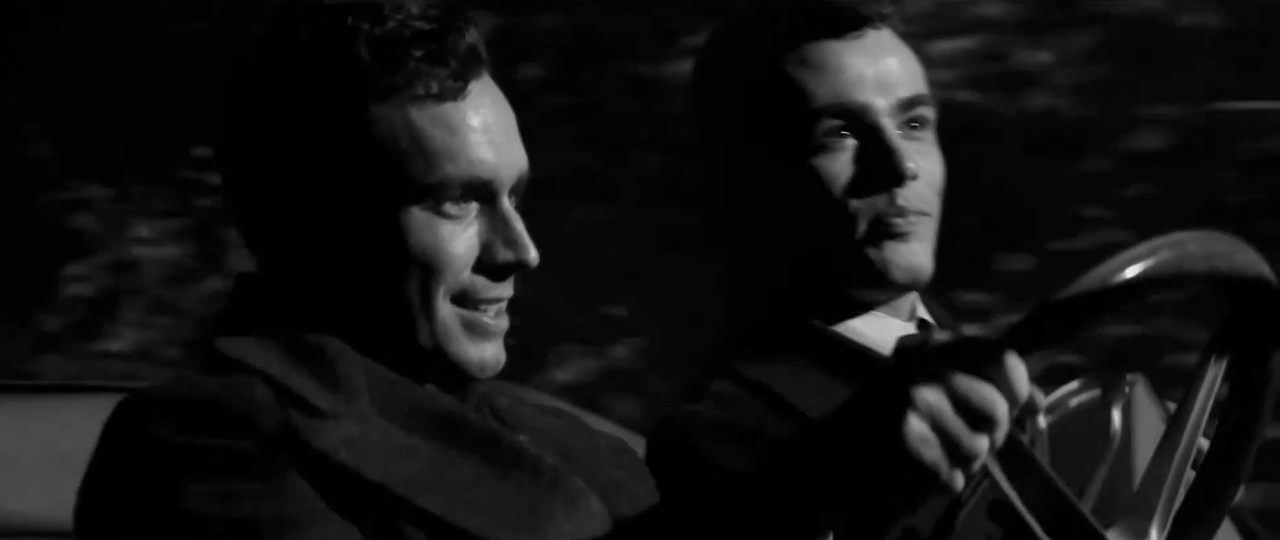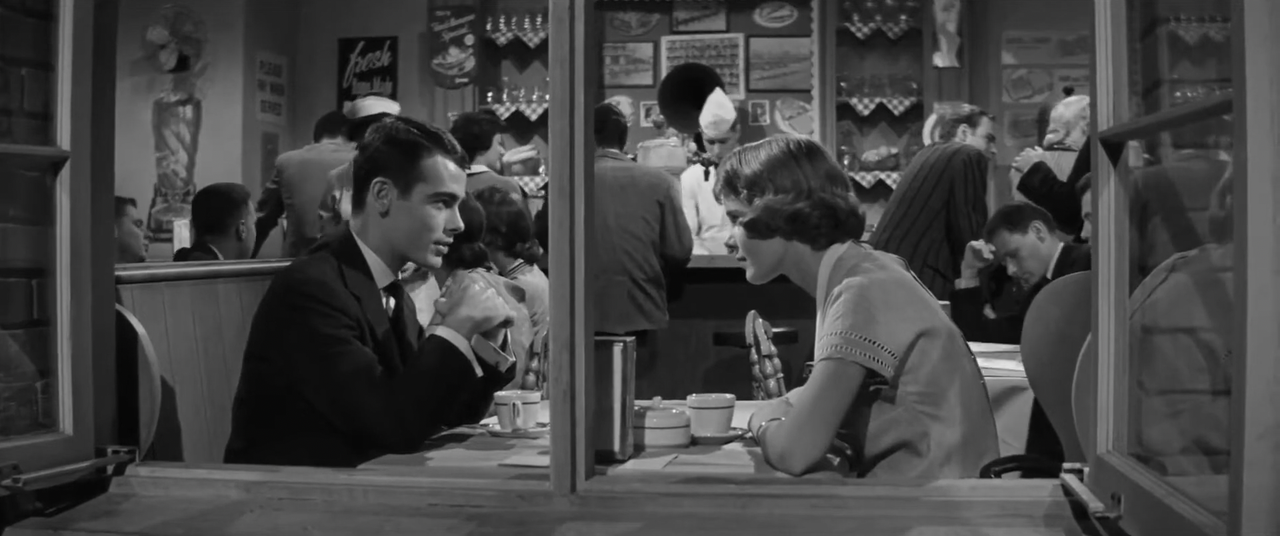OrsonWelles
“You need more than luck in Shanghai.”The Lady from Shanghai (Orson Welles, 1947)
Aug
9

Elsa Bannister (Rita Hayworth) and husband Arthur Bannister (Everett Sloane) in the dizzying modernist finale. DP: Charles Lawton Jr..
– Elsa Bannister
“Murder's nothing. It's just a simple experience. Murder and rape? Do you know what beauty there is in evil?”Compulsion (Richard Fleischer, 1959)
May
16

Straus (Bradford Dillman) with Steiner (Dean Stockwell) behind the wheel. They're beaming. DP: William C. Mellor.
“There's no clue to the identify of Franz Kindler; except one little thing. He has a hobby that almost amounts to a mania: clocks.”The Clock (Christian Marclay, 2010)
Dec
31
Hogmanay

Prof. Charles Rankin (Orson Welles) during the climax in The Stranger (1946). The clocktower strikes midnight. DP: Russell Metty.
Midnight: it's Hogmanay in Scotland.
– Mr. Wilson
The Clock takes place over – and lasts – 24 hours, with each moment either being shown in a film still or mentioned by characters during a scene. In total, there are over 12 000 scenes edited into Marclay's tour de force.
“Coil the bow-line into a sun shape.”Nóz w wodzie; The Lady from Shanghai
Apr
23
rigging


Top to bottom: Nóz w wodzie [Knife in the Water] (Roman Polanski, 1962), The Lady from Shanghai (Orson Welles, 1947).
Watched on April 23 and 26 respectively.
– Leon Niemczyk as Andrzej in Nóz w wodzie
“Europe, a Stutz Bearcat, the best restaurants. You fellas really have a hard life, don't you?”Compulsion (Richard Fleischer, 1959)
Jun
29
coffee

A squeaky young Stockwell and Varsi at a diner. We're looking in from the outside through an open window. The place is busy but she's all enthralled by his wit and intellect (and looks for sure). DP: William C. Mellor.
– Harold Horn, DA
“All these fancy electronics, they're all right in their place, but not for anything practical.”Le procès [The Trial] (Orson Welles, 1962)
Jun
23
National Typewriter Day

Josef K. (Anthony Perkins) crossing an enormous open office space. The endless room is filled with clerks, identical desks, telephones, and typewriters. DP: Edmond Richard.
Office worker Josef K. is brought to trial and at no point told what he is accused of, if anything. Orson Welles' Le procès is an adaptation of Franz Kafka's unfinished 1914/15 novel Der Prozess. The manuscript, guarded from Kafka by his friend #MaxBrod in an attempt to keep the self-doubting author from destroying his work, was against K's wishes posthumously (re)assembled by Brod without the latter knowing the intended sequence of the loose pages nor what chapters were finished.
– Uncle Max
The story holds up in its vagueness thanks to the quirks of #Kafka's Brotberuf; Franz K. was a trained lawyer, working as an insurance agent in an impossible artifice world of reports and precise wording. Within its extended logic, a man can get perplexedly lost, either within the walls of his #office or one's bed.
Malpertuis (Harry Kümel, 1971)
May
12
meat

Cassavius (Orson Welles), looking monstrous on his sickbed, surrounded by peopel who appear to be in mourning. On his bed's foot-end a large silver platter with cooked meat, and a rat on its hind legs. DP: Gerry Fisher.
“Back to the old tricks.”Vérités et Mensonges [F for Fake] (Orson Welles, Gary Graver, Oja Kodar + François Reichenbach, 1973)
March
29
Smoke And Mirrors Day

A wide shot of Orson Welles in his black cape and wide rimmed hat. His corpulence and black outfit sharply contrast with the bright, white background. The background is a white plane, held up by two assistants. The wide shot reveals that Welles, the white plane, and the assistants are on the platform of a train station, obscuring a passenger train if in close-up. DP: François Reichenbach.
Vérités et Mensonges is what it's actually called, but you may know it as F for Fake. Orson Welles and three uncredited fellow conspirators – Gary Graver, Oja Kodar, and François Reichenbach – delve into the world of #art forger Elmyr de Hory by way of his biographer Clifford Irving.
– Orson Welles
Welles et al free-associate with concepts of art, lies, #deception, and #authenticity. #Houdin, Welles, #Picasso and Hughes, hoaxers, hucksters and artists in their own right. And then it's over: this work of art, this sleight of hand, this demonstration of factuality, an exposé.
